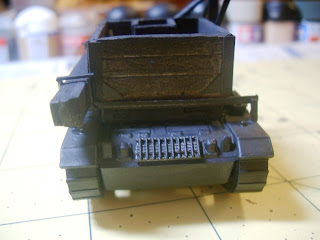... for all seasons, or sides. A couple of months ago I bought a very nice Matchbox diecast 'Yesteryear' model from the £1 bucket at one of my local antique/junk emporiums. It was just calling out to be turned into a staff car, which I did this evening. The result is a very flexible bit of wargame kit:
First, Russian officers on the Eastern Front during the Great War - when the Russians could invade Prussia without acting like barbarians.
Sometime later (when barbarism stalked the land), White Russian officers pose by their staff car.
While Prussian officers, feeling a little lost, carry on fighting in the East.
And the French intervene,
And Johnny Turk dreams of a new Empire, but this time a Turkic one that doesn't include those dam' annoying, not to say, revolting Arab types.
Actually, I do wonder whether some Turks aren't thinking about something similar today - a new, eastern orientated sphere of influence. It is quite clear that Turkey is unlikely to be admitted to the EU (for a host of reasons), the old Ataturk/Army grip on Turkey is probably at an end, and there is a strong Islamist (but not in the sense of raving loonies) government and movement in Turkey. Add to all that the mess in Syria, where Turkey clearly has interests, fears, but also, perhaps, new opportunities; and the rapid decline in Turkish-Israeli links, and it seems that a new future as a regional power may be beckoning for Turkey.
But back to the staff car and the figures. All of my 28mm types here are drawn from my armies inspired by Copplestone's
Back of Beyond, and I've had some dashed good games with 'em. Of course, the required reading for that sort of stuff is
Peter Hopkirk's marvellous series of books about the 'Great Game', Central Asia, the Silk Road, and all the Romance, squalor and horror that went with it. There are plenty of books around to add into the mix, for example, Robert Johnson's more academic, but perhaps not so gripping,
Spying for Empire; the Great Game in Central and South Asia, 1757-1947 (Greenhill, London, 2006), the bibliography of which provides a lifetime of Great Game reading; and my favourite contemporary work, F.James'
Faraway Campaign (reprint, Leonaur, 2007), which I have enthused about here before. But, for a really ripping good read, this can't be beaten:

John Buchan's absolute classic, first published in 1916, and remarkably accurate in many ways. This is a very nice 1937 printing by Thomas Nelsons (once Edinburgh's great publishing house) that I bought for 40p many years ago when it was still possible to drink 70/- ale in 'The Green Mantle' pub, just an undergraduate's stone throw from Edinburgh University.
Looking at the photos in this post, you may be asking yourself, 'yes, yes, but where are the Bolshevik military elite posing with this staff car?'. And I reply, 'don't make me larf! Do you think the great red leather clad Bolshevik warlord would be seen dead in a Vauxhall ? You must be joking, only a Rolls Royce, with tracks no less, was good enough for old Trot.' Give me
Alexander Berkman any day.




















































